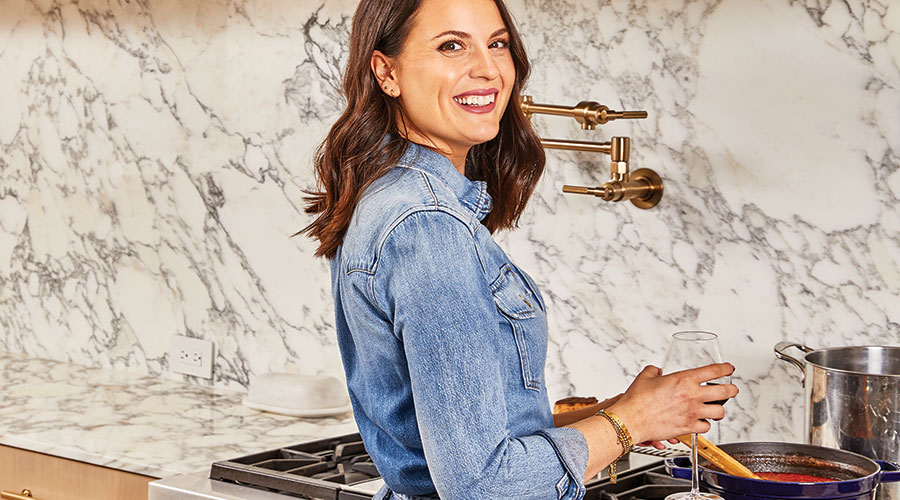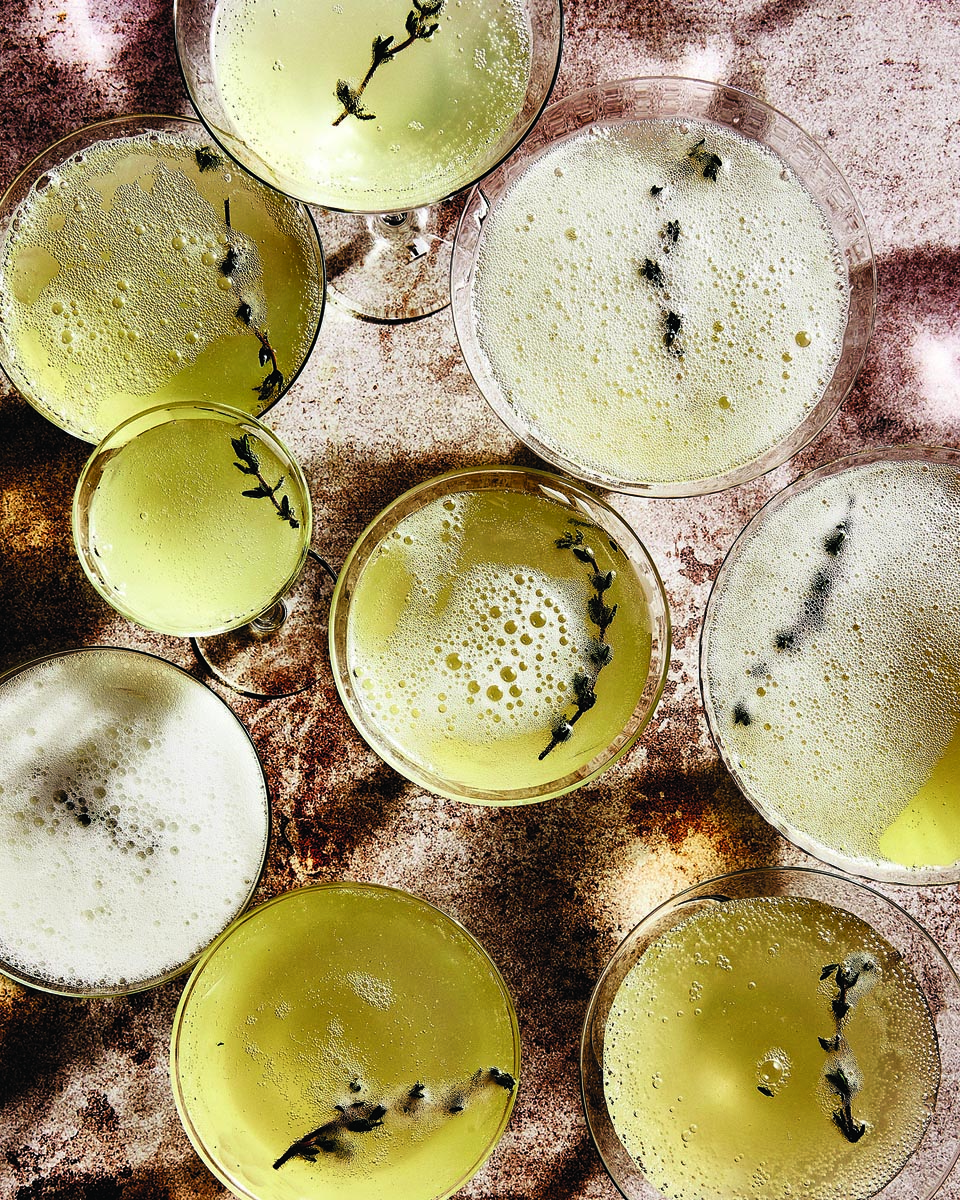
Food is LOVE
By June Naylor
Photos by Kristen Kilpatrick
With her second cookbook, Alex Snodgrass turns to family, past and present, in making memorable meals
Alex Snodgrass proves that timing is everything, even when it looks like fate is not on your side.
A TCU grad, Dallasite Snodgrass is the social media food star whose first book, The Defined Dish, was published before the pandemic’s arrival two years ago. She had just finished a coast-to-coast book tour — her debut volume rose quickly on The New York Times bestseller list — when the lockdown set in.
She was starting work on her follow-up book, The Comfortable Kitchen: 105 Laid-Back, Healthy, and Wholesome Recipes, when, fortuitously, she found herself shifting with the times. The new title was released this winter.
“Stay-at-home orders happened just as I was beginning the new book,” Snodgrass recalls of being secluded 24/7 with husband Clayton and their two little girls. “We were spending so much time together that I began to clearly remember those times around the table when I was growing up. It was a good reminder for me about the joy of cooking with people you love and the relationships built there. That became my theme throughout this book.”
A native of Celina, near Denton, Snodgrass began combing through recipe cards penned by her grandmother and mother (a handful of yellowed, well-worn handwritten mementos are pictured in The Comfortable Kitchen). “It was such a good way to remember and reconnect with them,” she says. True to her own health-minded cooking traditions, Snodgrass fashioned meals after her childhood favorites — think: beef stroganoff, pigs in blankets, chicken potpie, tamale pie, broccoli-cheese soup — but massaged them with smart adaptations for paleo, gluten-free, and/or dairy-free diets using today’s herbs and seasonings.
Along with the comfort dishes, Snodgrass provides home cooks with clever, easy ways to create lively dishes for the contemporary palate, from Spiced Lamb Lettuce Cups with Tzatziki and Spicy Miso Ramen with Pork to Mediterranean-Seared Tuna Salad and a hearty entree of Mongolian Mushrooms. Staying true to the kind of cooking that launched her brand, the book also speaks to her commitment to the interests of her nearly 650,000 Instagram followers.
“My first book was an extension of me and my blog, focusing on the Whole30 cooking that impacted the way I eat and shop,” Snodgrass explains. “For this book, I wanted to showcase food freedom, finding a place where you’re comfortable with how you’re eating. And the community still wanted dinner and weeknight cooking, which was one extension of the first book.”
This time around, though, she augments her repertoire with dinner party options, including chapters on appetizers and cocktails — the latter a specialty of her husband, a Fort Worth native and real estate developer (and now partner in the William Campbell Gallery). His chapter is aptly called Clayton’s Cocktails, and it offers his twists on libations including the Whiskey Sour, tweaked with elderflower liqueur; the Mezcal Mule, instead of the vodka-fueled Moscow Mule; and the French 75, made with fresh thyme and Hendrick’s, a favorite Scottish gin.
Thyme 75
Serves 2
- 3 ounces gin
- 2 ounces freshly squeezed lemon juice (about 1 lemon)
- 2 ounces thyme simple syrup, see Note
- Brut cava, to top
- 2 fresh thyme sprigs, for garnish
In cocktail shaker filled with ice, combine gin, lemon juice and thyme simple syrup. Shake until very cold, at least 20 seconds. Strain into 2 coupe glasses (preferably chilled) and top with cava. Garnish each with thyme sprig.
Note Make thyme simple syrup by combining 1 cup water and 1 cup sugar in saucepan, bringing to simmer over medium-high heat. Stir until sugar dissolves, 3 to 4 minutes. Remove from heat, add 10 to 12 thyme sprigs, set aside and cool to room temperature, about 30 minutes. Discard thyme. Store in airtight container in fridge for up to 2 weeks. Makes 1 cup.

The book’s photography, a balance of food, cooking, cocktails and lifestyle images, was shot at the recently remodeled Snodgrass home in North Dallas — not exactly what the author had planned: “We’d wanted to shoot this book in a studio in New York or LA with a food stylist. But COVID had us scrambling, and Clayton just said, ‘You did a great job at home on the first book, and you can do it again.’”
She hired a photography and styling team and put them up in a rented house near her home. The crew did all the grocery shopping and began shooting just as last February’s snow-and-ice storm hit. Everyone hunkered down at the Snodgrass home, which never lost power. “It was one giant slumber party,” she says. “There was plenty of food, of course, to feed my family and everyone else.”
As with her debut book, a busy tour will take her to both coasts and to Chicago this month. Her Texas events, including the Feb. 15 appearance at Whiskey Ranch in Fort Worth, are nearly all sold out. After that, relaxing is a top priority: “When the dust settles, we’re going on vacation, and I’m not thinking about what’s next.”
Until then, Snodgrass offers her idea of a best date-night dinner at home, which includes her Steak au Poivre. The paleo-friendly version uses sherry vinegar instead of the traditional cognac in the sauce. Side pairings from the book include roasted root vegetables and Little Gem salad.
For a more casual dinner, check out the pasta recipe we’re featuring as “The Dish” on Page 51

Steak Au Poivre
Serves 2
- 2 teaspoons black peppercorns
- 2 filet mignon steaks (6 to 8 ounces each)
- 1½ teaspoons kosher salt, or to taste
- 1 tablespoon avocado oil
- Au poivre sauce, see Note
Place peppercorns in a small zip-top plastic bag. On a cutting board, coarsely crush them with a meat mallet or heavy skillet bottom.
Pat steaks very dry with paper towels. Season on all sides with salt and 1 teaspoon crushed peppercorns, reserve rest for sauce (see Note). Press seasoning into steaks, massaging into surface. Set aside and let steaks rest at room temperature for 15 minutes.
Heat avocado oil in large (preferably cast iron) skillet over medium-high heat until oil just begins to shimmer but not smoke. Carefully transfer steaks to skillet and sear undisturbed until a deep brown crust forms, about 4 minutes per side for medium-rare or 5 to 6 minutes per side for well-done. Transfer steaks to cutting board to rest while making the sauce.
Note To make sauce, remove the skillet you used to cook steaks from heat and allow to cool about 2 minutes. Wipe any burned bits away with paper towels. Return skillet to medium heat. Melt 1 tablespoon ghee (also called clarified butter) or unsalted butter in skillet and add ¼ cup finely minced shallot and 2 minced garlic cloves. Cook, stirring often, until shallot is tender and garlic is fragrant, 1 to 2 minutes. Stir in 1 teaspoon Dijon mustard, 1 tablespoon sherry vinegar and ¼ cup low-sodium beef broth until well combined; bring to a rapid simmer. Using a spoon, scrape up any browned bits. Stir in ½ cup unsweetened, full-fat coconut milk, 1 teaspoon finely chopped fresh thyme leaves and reserved crushed peppercorns. Simmer, stirring often until sauce has thickened, about 4 minutes. Taste sauce and add pinch of salt, if desired. Plate steaks and spoon sauce on top; garnish with fresh thyme. Serve immediately.



